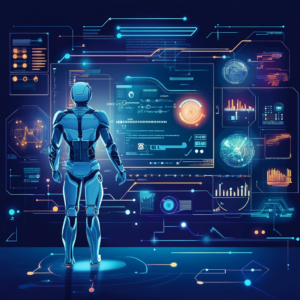1. Introduction
In today’s fast-paced digital era, the way we learn is constantly evolving. As an educator and digital learning strategist, I have witnessed firsthand how technology can transform education. This article, titled Emerging eLearning Technologies to Watch in 2025, provides an in-depth look at the next generation of digital learning tools that are set to revolutionize the educational landscape. Our focus keyword, Emerging eLearning Technologies to, encapsulates the essence of what you need to know to stay ahead of the curve. Over the following sections, I will explore the evolution of eLearning technology, the key trends driving innovation, and the specific emerging tools that promise to redefine how we teach and learn by 2025. For further insights on digital education strategies, click here to read Boosting Student Performance with Adaptive Learning Technologies.

2. The Evolution of eLearning Technologies
Over the past decade, eLearning has undergone a dramatic transformation. Initially, online courses were static and content-driven, relying on text and simple multimedia. However, as internet speeds improved and technology advanced, eLearning evolved into an interactive, engaging, and highly personalized experience. Digital classrooms have progressed from basic video lectures to dynamic virtual environments where learners interact with content, peers, and instructors in real time. Innovations such as adaptive algorithms and real-time analytics now enable educators to monitor student performance and tailor the learning journey to individual needs. This evolution is a powerful example of Emerging eLearning Technologies to continuously reshape education.
3. Key Trends and Drivers for 2025
Several factors are propelling the rapid advancement of eLearning technologies. A major driver is the increasing demand for personalized learning. As students seek tailored educational experiences, platforms are leveraging artificial intelligence to adapt content dynamically. Additionally, the integration of immersive technologies like virtual reality (VR) and augmented reality (AR) is creating deeply engaging learning experiences. Other drivers include the need for secure, verifiable credentials—spurring interest in blockchain technology—and the vast amounts of data generated by digital platforms, which fuel continuous optimization through advanced analytics. These trends highlight why staying informed about Emerging eLearning Technologies to is critical for educators and institutions alike.
4. Emerging Technologies to Watch in 2025
In this section, I detail seven emerging technologies that every educator should watch as we approach 2025.
4.1 AI and Machine Learning in eLearning
Artificial intelligence and machine learning are revolutionizing the educational landscape. AI-driven systems analyze vast amounts of data in real time, personalizing the learning experience for each student. Adaptive learning technologies use AI to adjust the pace and difficulty of content based on individual performance. Additionally, AI-powered chatbots can provide instant support and facilitate interaction, ensuring that learners receive timely assistance. Embracing Emerging eLearning Technologies to harness AI will lead to smarter content delivery and more effective teaching methods. For further reading on AI in education, you might refer to resources available on the U.S. Department of Education website.
4.2 Virtual Reality and Augmented Reality
Virtual Reality (VR) and Augmented Reality (AR) are among the most exciting innovations in digital education. These immersive technologies allow students to engage with content in three-dimensional environments. Imagine history lessons where you virtually visit ancient civilizations or science classes that let you explore complex biological systems in 3D. VR and AR not only boost engagement but also provide hands-on experiences that deepen understanding and retention. Integrating these tools into your curriculum exemplifies Emerging eLearning Technologies to revolutionize educational delivery.
4.3 Blockchain for Credentialing and Security
Verification and security of digital credentials have become a major concern in online education. Blockchain technology offers a robust solution by providing a decentralized, tamper-proof ledger for storing certifications and digital badges. Each certificate recorded on a blockchain is immutable and easily verifiable, enhancing trust among learners, educators, and employers. By adopting blockchain, institutions can streamline verification processes and increase transparency. This innovative approach is one of Emerging eLearning Technologies to ensure secure, verifiable educational outcomes. For additional insights, you may visit the OECD Education Portal.
4.4 Microlearning Platforms and Adaptive Learning
Microlearning delivers content in short, focused segments that are perfect for today’s busy learners. When combined with adaptive learning systems, microlearning becomes even more powerful—tailoring each lesson to individual learner needs. These platforms offer personalized, bite-sized lessons that are accessible on mobile devices, ensuring that education is flexible and engaging. This method is a prime example of Emerging eLearning Technologies to make learning more efficient and targeted.
4.5 Gamification and Social Learning Tools
Gamification introduces elements like points, badges, leaderboards, and rewards into the learning process, transforming education into a more engaging and competitive experience. Social learning platforms facilitate collaboration, enabling peer-to-peer interaction and group projects. These tools not only boost motivation but also foster a sense of community among learners. Integrating gamification and social learning is a key aspect of Emerging eLearning Technologies to enhance engagement and improve outcomes.
4.6 Big Data and Advanced Analytics
The massive amounts of data generated by eLearning platforms are a treasure trove of insights waiting to be uncovered. Big data technologies allow educators to process and analyze this information in real time, providing a detailed picture of learner behavior and course performance. Advanced analytics tools help identify trends, measure engagement, and pinpoint areas for improvement. Leveraging big data is a cornerstone of Emerging eLearning Technologies to drive continuous enhancement in educational strategies. For scientific research on data analytics in education, consider exploring journals indexed in PubMed or Google Scholar.
4.7 Internet of Things (IoT) in Education
The Internet of Things (IoT) is beginning to play a role in education by connecting various devices to create a more interactive learning environment. Smart devices and sensors can track physical engagement in classrooms, monitor environmental factors, and even integrate with wearable technology to provide real-time feedback on student activity. This interconnected ecosystem enables a seamless flow of information that supports adaptive and personalized learning experiences. Incorporating IoT is another example of Emerging eLearning Technologies to watch as it expands the horizons of digital education.
5. Impact on Learners and Educators
The adoption of Emerging eLearning Technologies to innovate the educational experience has profound effects on both learners and educators. For students, these technologies offer more engaging, personalized, and interactive learning environments where they can learn at their own pace, receive real-time feedback, and access immersive content that simplifies complex subjects. For educators, advanced analytics, AI, and adaptive learning tools provide invaluable insights into student performance, allowing for more effective instruction and timely interventions. This transformation not only improves academic outcomes but also enhances satisfaction and retention.
6. Challenges and Considerations
While the promise of Emerging eLearning Technologies to transform education is immense, several challenges must be addressed to ensure successful implementation and long-term sustainability. In this section, I will discuss these challenges in detail and explore strategies for mitigating them.
6.1 Financial Constraints and Investment Costs
One of the foremost challenges is the significant initial investment required to adopt cutting-edge technologies such as VR, AI, and blockchain. Institutions must carefully evaluate the cost-benefit ratio of these investments, balancing short-term expenditures with the long-term gains in learner outcomes and operational efficiency. Funding sources, budget allocation, and potential returns on investment are critical factors to consider. In many cases, securing external funding or partnering with technology providers can help mitigate financial burdens. It is also important to plan for ongoing costs related to maintenance, updates, and infrastructure improvements as part of the overall strategy for Emerging eLearning Technologies to drive education forward.
6.2 Technological Integration and Infrastructure
Integrating new technologies with existing Learning Management Systems (LMS) and IT infrastructure presents another set of challenges. Seamless integration is crucial for ensuring that data flows smoothly between different systems and that learners experience a unified platform. Technical issues such as compatibility, system downtime, and the need for custom development can complicate the process. Institutions must invest in robust IT support and consider phased implementation strategies to gradually introduce Emerging eLearning Technologies to without disrupting current operations. Additionally, ensuring that the infrastructure is scalable and adaptable to future technological advances is vital for long-term success.
6.3 Data Privacy and Security Concerns
As eLearning platforms increasingly rely on data analytics, AI, and blockchain, data privacy and security become paramount. Handling sensitive learner information requires strict adherence to data protection regulations such as GDPR and other local privacy laws. The use of blockchain for credentialing, for instance, while promising in terms of security, also raises concerns about the management and storage of immutable data. Institutions must implement comprehensive cybersecurity measures, conduct regular audits, and invest in secure cloud solutions to protect against breaches. It is essential to establish clear data governance policies to ensure that Emerging eLearning Technologies to are utilized responsibly and ethically.
6.4 Training and Adoption Challenges
The rapid pace of technological change can create a steep learning curve for both educators and learners. Successful adoption of Emerging eLearning Technologies to requires extensive training and professional development. Educators need to be proficient not only in using new tools but also in interpreting data analytics to tailor instruction effectively. Similarly, students must be guided on how to navigate and benefit from these advanced learning environments. Continuous training programs, workshops, and technical support are critical to overcoming resistance to change and ensuring that all users can maximize the benefits of innovative technologies.
6.5 Scalability and Adaptability of Platforms
As the number of users and the complexity of digital content grow, scalability becomes a critical factor. Platforms that work well on a small scale may struggle under the increased load of a growing learner base. Ensuring that Emerging eLearning Technologies to are built on scalable architectures is essential for long-term success. Additionally, the platforms must be adaptable, capable of integrating future innovations without requiring complete overhauls. This requires a flexible design philosophy and the willingness to continuously iterate based on user feedback and evolving technological standards.
6.6 Policy, Regulation, and Future Research
Beyond technical and financial challenges, policy and regulatory issues also play a significant role. As governments and international bodies update educational standards and data protection laws, institutions must remain compliant while still innovating. This means staying informed about regulatory changes and possibly influencing policy through research and advocacy. Engaging with academic and industry research can provide valuable insights into best practices for implementing Emerging eLearning Technologies to. Furthermore, collaboration with policymakers and educational authorities can help create an environment that supports innovation while safeguarding learner rights.
6.7 Strategies for Overcoming Challenges
To effectively tackle these challenges, a multi-pronged strategy is essential:
- Develop a Comprehensive Implementation Plan: Clearly outline the goals, timelines, and resources required for integrating new technologies.
- Secure Adequate Funding: Explore diverse funding options, including government grants, partnerships, and private investments.
- Invest in Training and Support: Establish ongoing professional development programs for educators and technical support for both staff and students.
- Ensure Robust Infrastructure: Upgrade IT systems and select scalable, adaptable platforms that can grow with your organization.
- Prioritize Data Security: Implement state-of-the-art cybersecurity measures and develop clear data governance policies.
- Engage with Stakeholders: Involve educators, learners, and policymakers in the planning and evaluation process to ensure that the new technologies meet real-world needs.
- Monitor and Evaluate: Continuously track performance using 7 Key Metrics Every system and be prepared to make iterative improvements based on data-driven insights.
By addressing these areas comprehensively, institutions can not only overcome the challenges but also unlock the full potential of Emerging eLearning Technologies to revolutionize digital education.
7. Future Outlook and Predictions for 2025
Looking ahead, the eLearning landscape is set to be dramatically reshaped by emerging technologies. Experts predict that the convergence of AI, VR, blockchain, microlearning, gamification, big data, and IoT will create a highly interconnected and personalized educational ecosystem. Increased mobile access and faster internet speeds will further drive the adoption of these innovations on a global scale.
In 2025, I anticipate that Emerging eLearning Technologies to will become even more seamless, with platforms offering hyper-adaptive learning experiences that cater to each student’s unique needs. Predictive analytics will enable educators to foresee and address learning challenges proactively. Blockchain will enhance the credibility and security of digital credentials, while VR and AR will revolutionize experiential learning. Additionally, the integration of IoT will connect the physical and digital realms, providing holistic insights into student engagement. The future promises an educational environment that is data-driven, immersive, and highly personalized.
For a broader perspective on global trends in education technology, you might consider visiting the UNESCO Education Portal, which offers authoritative insights and reports on digital learning worldwide.
7.6 Recommended Resource for Future Trends
For a deeper understanding of emerging trends and practical applications of advanced data analytics in education, click here to watch this YouTube video on the future of online course tools. The video offers expert insights and real-world examples that complement the strategies discussed in this guide.

Call to Action
I would like to mention a top-notch digital product that has significantly improved my approach to communication. It is a comprehensive infoproduct that offers detailed strategies and practical tools to improve communication. Additionally, join our vibrant community by subscribing to our newsletter. Receive expert tips, updates on emerging trends, and exclusive offers directly in your inbox to help you create personalized, high-impact eLearning experiences. Sign up now and take your digital classroom to the next level.
8. Case Studies and Success Stories
Real-world examples provide compelling evidence of the benefits of Emerging eLearning Technologies to transform education. One university implemented an AI-driven adaptive learning system that led to a 30% increase in course completion rates and significantly improved student satisfaction. By leveraging advanced analytics, the institution was able to tailor learning experiences to individual needs, resulting in measurable improvements in academic performance.
Another case study from a global online learning platform showcased the successful integration of VR and AR technologies. Students reported higher engagement and better understanding of complex subjects when immersive learning experiences were incorporated into the curriculum. Additionally, blockchain-based credentialing enhanced trust and streamlined the verification process, leading to increased enrollment and improved employer recognition of digital certifications.
These success stories demonstrate that when institutions adopt Emerging eLearning Technologies to innovate their educational approaches, they can achieve remarkable improvements in both learning outcomes and operational efficiency.
To further boost your online teaching career, explore our exclusive product, the study planner, organize your time and create study strategies with My Planner. Additionally, join our vibrant community by subscribing to our newsletter. Receive expert tips, updates on emerging trends, and exclusive offers directly in your inbox to help you create personalized, high-impact eLearning experiences. Sign up now and take your digital classroom to the next level.
9. Conclusion
Emerging eLearning Technologies to Watch in 2025 represent a paradigm shift in how education is delivered and experienced. By embracing innovations such as AI, VR, blockchain, microlearning, gamification, big data analytics, and IoT, educators can create more engaging, personalized, and effective learning environments. These technologies not only enhance the overall quality of education but also empower both learners and educators to achieve higher performance and satisfaction.
As we approach 2025, the future of eLearning will be defined by continuous innovation and the seamless integration of advanced digital tools. The strategic adoption of Emerging eLearning Technologies to is key to staying competitive in the rapidly evolving digital landscape. By leveraging these technologies, educational institutions can build dynamic, responsive platforms that meet the diverse needs of modern learners and deliver measurable results.
Before concluding, I encourage you to reflect on how these emerging technologies can transform your teaching methods and enhance the learning journey. Embrace the power of data-driven, adaptive, and immersive educational experiences to build a future-proof eLearning platform that not only meets but exceeds learner expectations.

10. Frequently Asked Questions (FAQ)
Q1: What are emerging eLearning technologies?
A1: Emerging eLearning technologies are innovative digital tools—such as AI, VR, blockchain, adaptive learning systems, IoT, and gamification—that are set to transform the educational landscape.
Q2: How can AI improve online learning experiences?
A2: AI personalizes learning by adapting content in real time, providing tailored feedback, and predicting learner needs, which enhances engagement and outcomes.
Q3: What role does VR play in eLearning?
A3: VR creates immersive, interactive learning experiences that allow students to engage with content in realistic, 3D environments, improving understanding and retention.
Q4: How does blockchain enhance eLearning?
A4: Blockchain provides secure, tamper-proof digital credentials, increasing trust and transparency in the certification process.
Q5: Why is big data important in eLearning?
A5: Big data enables real-time analytics and continuous monitoring of learner behavior, allowing for swift adjustments to optimize learning outcomes.
Thank you for reading this comprehensive guide on Emerging eLearning Technologies to Watch in 2025. I hope the insights, strategies, and practical tips provided here empower you to harness the power of emerging technologies and transform your eLearning environment into a cutting-edge, effective learning platform. If you have any questions or need further adjustments, please let me know!
